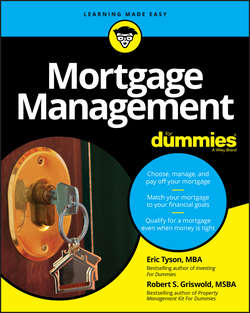Читать книгу Mortgage Management For Dummies - Tyson MBA Eric - Страница 1
Mortgage Management For Dummies by Eric Tyson and Robert Griswold
ОглавлениеEric and Robert’s Top Tips for Borrowers
❯❯ Before you get a mortgage, be sure you understand your personal financial situation. The amount of money a banker is willing to lend you isn’t necessarily the amount you can “afford” to borrow given your financial goals and current situation. See Chapter 1.
❯❯ Maximize your chances for getting the mortgage you want the first time you apply by understanding how lenders evaluate your creditworthiness. Don’t waste time and money on loans that end up rejected. Most obstacles to mortgage qualification can and should be overcome prior to submitting a loan application. See Chapters 2 and 3.
❯❯ Because the ocean of mortgage programs is bordered with reefs of jargon, learn loan lingo before you begin your mortgage-shopping voyage. This will enable you to hook the best loan and avoid being taken in by loan sharks. See Chapter 4 and Appendix C, the Glossary.
❯❯ To select the best type of fixed-rate or adjustable-rate mortgage for your situation, clarify two important issues. How long do you expect to keep the loan? How much financial risk are you able to accept? See Chapter 5.
❯❯ Special situation loans – such as a home equity loan or 80-10-10 financing – could be just what you need. However, some “special” loans, such as 100 percent loans and balloon loans, can be toxic. See Chapter 6.
❯❯ Whether you do it yourself or hire a mortgage broker to shop for you, canvas a variety of lenders when seeking the best mortgage. Be sure to shop not only for a low-cost loan but also for lenders that provide a high level of service. See Chapter 7.
❯❯ Investigate when shopping for a mortgage on the Internet. Be cautious. You may save time and money. Or you could end up with aggravation and a worse loan. See Chapter 8.
❯❯ Compare various lenders’ mortgage programs and understand the myriad costs and features associated with each loan. To help you keep score and do a fair comparison, we provide helpful worksheets. See Chapter 9.
❯❯ Just as you must prepare a compelling résumé as the first step to securing a job you want, craft a positive, truthful mortgage application as a key to getting the loan you want. See Chapter 10.
❯❯ After you get a mortgage to purchase a home, stay informed about interest rates, because a drop in rates could provide a money-saving opportunity. Refinancing – that is, obtaining a new mortgage to replace an existing one – can save you big money. Assess how long it will take you to recoup your out-of-pocket refinance costs. See Chapter 11.
❯❯ You may benefit from paying off your mortgage faster than is required. But before you do, examine what else you could do with that extra cash and what may be best for your situation. See Chapter 12.
❯❯ If you’re among the increasing number of homeowners who reach retirement with insufficient assets for their golden years, carefully consider a reverse mortgage, which enables older homeowners to tap their home’s equity. Reverse mortgages are more complicated to understand than traditional mortgages. See Chapter 13.
❯❯ If you fall on tough economic times and get behind on your housing payments, don’t resign yourself to foreclosure. Take stock of the situation. Review your spending and debts and begin a dialogue with your lender to find a solution. Make use of low-cost counseling approved by the U.S. Department of Housing and Urban Development. See Chapter 14.
❯❯ Use the Loan Amortization Tables in Appendix A to determine your monthly payment after you know a loan’s interest rate and term (number of years until final payoff).
❯❯ After you’ve had a loan awhile, see the Remaining Balance Tables in Appendix B to know how much of your original loan balance remains to be paid.
Mortgage Payment Calculator 1
To calculate your monthly mortgage payment, simply multiply the relevant number from the following table by the size of your mortgage expressed in (divided by) thousands of dollars. For example, on a 30-year mortgage of $125,000 at 7.5 percent, you multiply 125 by 7.00 (from the table) to come up with an $875 monthly payment.
Copyright © 2017 Eric Tyson and Robert Griswold
All rights reserved.
1
Warning: Mortgage payments are only a portion of the costs of owning a home. See Chapter 1 for figuring out your total costs and fitting them into your personal finances.
